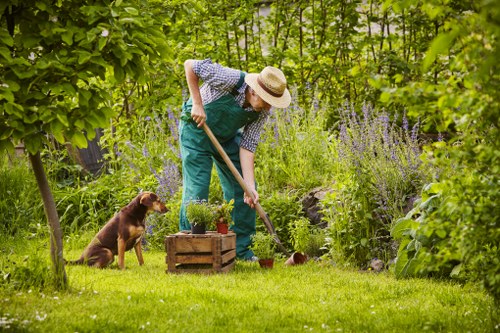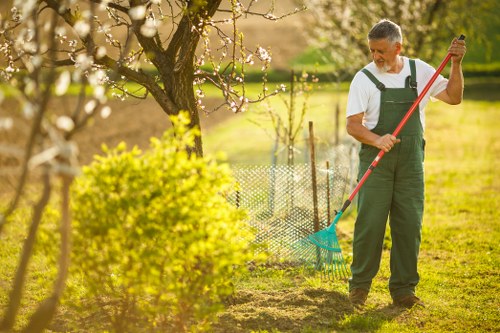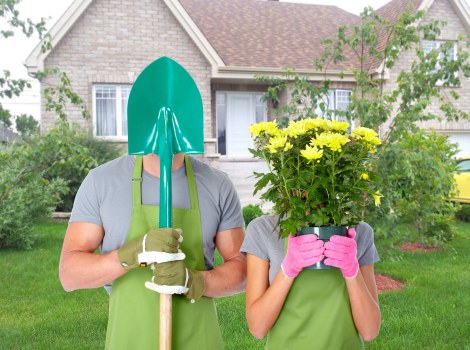Landscape Gardening in Mill Hill

Mill Hill, a picturesque suburb located in the northwest of London, offers a unique blend of urban convenience and serene natural beauty. For residents and property owners in Mill Hill, landscape gardening is not just a hobby but a transformative practice that enhances the aesthetic appeal and value of their homes.
Whether you are new to gardening or a seasoned enthusiast, understanding the nuances of landscape gardening in Mill Hill can help you create a stunning outdoor space tailored to your preferences and the local climate. This comprehensive guide delves into various aspects of landscape gardening, providing insights and tips to help you achieve a beautiful and sustainable garden.
From selecting the right plants and designing your garden layout to maintaining your outdoor space throughout the year, this article covers everything you need to know about landscape gardening in Mill Hill. Let’s embark on a journey to transform your garden into a tranquil haven.

Understanding the Mill Hill Climate
Mill Hill enjoys a temperate maritime climate, characterized by mild summers and cool winters. This climate is conducive to a wide variety of plants, allowing gardeners to experiment with different species and plant combinations. However, understanding the specific weather patterns and soil conditions in Mill Hill is crucial for successful landscape gardening.
The average annual rainfall in Mill Hill is approximately 600mm, which supports lush greenery and thriving plant life. Summers are generally warm, with temperatures ranging between 15°C to 25°C, while winters can be chilly, with temperatures occasionally dropping below freezing. Gardeners must select plants that can withstand these temperature variations to ensure their gardens remain vibrant year-round.
Soil quality in Mill Hill varies, but most areas feature fertile, well-draining soil, ideal for a diverse range of plants. Conducting a soil test can provide valuable information about pH levels and nutrient content, enabling gardeners to amend the soil as needed for optimal plant growth.

Designing Your Garden Layout
Assessing Your Space
Before diving into plant selection and landscaping elements, it is essential to assess the available space. Consider factors such as the size of your garden, existing structures, sunlight exposure, and accessibility. Taking accurate measurements and sketching a rough layout can help in visualizing the final outcome.
Choosing a Style
Mill Hill offers a variety of garden styles to suit different tastes and preferences. Popular styles include:
- Traditional English Garden: Characterized by formal layouts, neatly trimmed hedges, and a variety of flowering plants.
- Modern Minimalist Garden: Focuses on clean lines, simple plant selections, and uncluttered spaces.
- Wildlife Garden: Designed to attract and support local wildlife, featuring native plants and natural habitats.
- Zen Garden: Emphasizes tranquility and simplicity, often incorporating elements like gravel, rocks, and water features.
Selecting a style that resonates with your personal preferences and complements your home’s architecture sets the foundation for a cohesive garden design.
Creating Zones
Dividing your garden into distinct zones can enhance its functionality and aesthetic appeal. Common zones include:
- Seating Area: A dedicated space for relaxation and social gatherings, often featuring benches, chairs, or a dining set.
- Planting Beds: Areas designated for flower beds, shrubs, and trees, organized based on plant height and growth habits.
- Pathways: Walkways that connect different parts of the garden, made from materials like gravel, stone, or paving slabs.
- Water Features: Elements such as ponds, fountains, or birdbaths that add sound and movement to the garden.

Selecting the Right Plants
Plant selection is a crucial aspect of landscape gardening. In Mill Hill, gardeners have access to a wide range of plants that thrive in the local climate. Here are some categories and recommendations to consider:
Trees and Shrubs
- Ornamental Trees: Species like the Japanese Maple or Cherry Blossom provide stunning foliage and seasonal blooms.
- Evergreen Shrubs: Plants such as Boxwood or Holly maintain their foliage year-round, offering structure and greenery even in winter.
- Flowering Shrubs: Options like Hydrangea or Lavender add vibrant colors and pleasant fragrances to the garden.
Perennials and Annuals
- Perennials: Plants like Hostas, Daylilies, and Coneflowers come back year after year, providing consistent beauty with minimal maintenance.
- Annuals: Annual plants such as Petunias, Marigolds, and Impatiens offer a burst of color each season, allowing for flexibility in design.
Groundcovers and Vines
- Groundcovers: Creeping Thyme, Sedum, and Ajuga help prevent soil erosion and reduce weed growth.
- Vines: Climbing plants like Ivy, Clematis, and Wisteria can add vertical interest and cover unsightly structures or fences.
Edible Plants
Incorporating edible plants into your landscape garden can be both functional and aesthetically pleasing. Consider planting:
- Fruit Trees: Apple, Pear, or Plum trees provide fresh fruits and add beauty through their blossoms.
- Herbs: Basil, Rosemary, and Mint are easy to grow and can be used in culinary endeavors.
- Vegetables: Tomatoes, Peppers, and Lettuce can thrive in well-planned garden beds.
Seasonal Considerations
To ensure year-round interest, select a mix of plants that bloom or exhibit unique features in different seasons. This might include spring bulbs, summer annuals, autumn foliage, and winter evergreens. Planning for seasonal diversity keeps your garden vibrant and engaging throughout the year.

Hardscaping Elements
While plants are the heart of any garden, hardscaping elements play a significant role in defining the space and providing structure. Here are some key hardscaping components to consider:
Paths and Walkways
Paths guide movement through the garden and can be made from various materials such as gravel, brick, stone, or concrete. Curved pathways add a sense of exploration, while straight paths offer a formal and structured feel.
Patios and Decks
Patios and decks create outdoor living spaces for dining, lounging, or entertaining. Choosing durable materials and incorporating comfortable furnishings can make these areas inviting and functional.
Fencing and Boundaries
Fences provide privacy, security, and can also serve as a backdrop for climbing plants. Selecting a style that complements your garden design, whether it’s traditional wooden fencing or modern metal panels, is essential.
Water Features
Water features such as fountains, ponds, or waterfalls add a soothing sound and a focal point to your garden. They can also attract wildlife like birds and insects, enhancing the ecological diversity of your landscape.
Lighting
Garden lighting extends the usability of your outdoor space into the evening and highlights key features. Options include solar-powered lights, spotlights, and string lights, each offering different aesthetic and functional benefits.
Garden Structures
Structures like pergolas, arbors, and gazebos provide shade, support climbing plants, and create designated spaces within the garden. These elements add architectural interest and can be customized to match your design vision.
Mulching and Path Borders
Mulch helps retain soil moisture, suppress weeds, and improve soil health. Additionally, defining paths with borders made of stones, bricks, or metal can enhance the overall appearance and maintain the integrity of your garden layout.

Maintaining Your Landscape Garden
Regular Watering
Consistent watering is vital for the health of your plants, especially during dry spells. Installing an efficient irrigation system, such as drip irrigation or soaker hoses, can ensure that your garden receives adequate moisture without wasting water.
Pruning and Trimming
Regular pruning helps maintain the shape and size of your plants, promotes healthy growth, and prevents overgrowth that can lead to disease. Understanding the specific pruning needs of each plant species is essential for effective maintenance.
Weeding
Weeds compete with your garden plants for nutrients and water, so removing them promptly is crucial. Mulching and using groundcovers can help reduce weed growth, making garden maintenance easier.
Fertilizing
Providing your plants with the necessary nutrients ensures robust growth and vibrant blooms. Use organic fertilizers or compost to enrich the soil naturally, promoting a healthy and sustainable garden ecosystem.
Pest and Disease Management
Monitoring your garden for signs of pests and diseases allows for early intervention. Employing natural pest control methods, such as encouraging beneficial insects or using organic pesticides, can help maintain the health of your garden without harming the environment.
Seasonal Maintenance
Each season brings its own set of maintenance tasks. For instance, spring involves preparing the garden beds and planting new plants, while autumn requires clearing fallen leaves and preparing plants for winter. Adapting your maintenance routine to the changing seasons ensures a thriving garden year-round.
Pro Tips for Garden Maintenance
- Stay Consistent: Regular maintenance prevents minor issues from becoming major problems.
- Keep Records: Documenting your gardening activities helps track what works and what doesn’t.
- Stay Informed: Continuously educate yourself about gardening techniques and plant care.
- Use Quality Tools: Investing in good gardening tools makes maintenance tasks easier and more efficient.

Incorporating Sustainable Practices
Sustainability is increasingly becoming a priority in landscape gardening. Implementing eco-friendly practices not only benefits the environment but also contributes to a healthier and more resilient garden.
Composting
Creating a compost pile or using a compost bin recycles kitchen and garden waste into nutrient-rich compost. This natural fertilizer enhances soil structure, retains moisture, and reduces the need for chemical fertilizers.
Rainwater Harvesting
Collecting rainwater through barrels or other storage systems provides a sustainable water source for your garden. Rainwater is often softer and free from chemicals found in tap water, making it beneficial for plant health.
Native Plants
Using native plants in your garden supports local biodiversity and requires less maintenance. Native species are well-adapted to the local climate and soil conditions, making them more resilient to pests and diseases.
Energy-Efficient Lighting
Opting for solar-powered or LED garden lighting reduces energy consumption and lowers your carbon footprint. These lighting options are not only eco-friendly but also cost-effective in the long run.
Permaculture Principles
Incorporating permaculture principles, such as designing for maximum biodiversity and creating self-sustaining ecosystems, fosters a harmonious relationship between your garden and the natural environment.
Reducing Chemical Use
Minimizing the use of chemical pesticides and fertilizers protects beneficial insects and microorganisms in the soil. Instead, use organic alternatives and integrated pest management techniques to maintain a healthy garden.
Benefits of Sustainable Gardening
- Environmental Protection: Reduces pollution and conserves natural resources.
- Cost Savings: Reduces the need for expensive inputs like fertilizers and water.
- Healthier Plants: Promotes strong, disease-resistant plant growth.
- Enhanced Biodiversity: Supports a variety of wildlife, from pollinators to beneficial insects.
Embracing sustainable gardening practices not only contributes to the well-being of your garden but also plays a part in preserving the environment for future generations.

Hiring Professional Landscape Gardeners in Mill Hill
While DIY gardening can be rewarding, hiring a professional landscape gardener in Mill Hill offers numerous benefits. Professionals bring expertise, experience, and a creative vision that can elevate your garden to new heights.
Benefits of Professional Landscaping
- Expert Design: Professionals can create intricate garden designs tailored to your specific needs and preferences.
- Time Savings: Landscaping can be time-consuming; professionals handle the tasks efficiently, allowing you to enjoy your garden sooner.
- Knowledge of Local Conditions: Local landscapers understand the Mill Hill climate, soil conditions, and native plants, ensuring your garden thrives.
- Access to Resources: Professionals have access to a wider range of materials, plants, and tools, which can enhance the quality of your garden.
- Maintenance Plans: Many landscaping companies offer ongoing maintenance services to keep your garden in pristine condition.
Choosing the Right Professional
Selecting the right landscape gardener involves considering several factors:
- Experience and Portfolio: Review their previous work to gauge their style and expertise.
- Qualifications: Ensure they have the necessary qualifications and certifications.
- Client Reviews: Testimonials and reviews provide insights into their reliability and quality of work.
- Cost Estimates: Obtain detailed quotes to understand the pricing structure and avoid hidden costs.
- Communication: Choose a professional who listens to your ideas and communicates clearly throughout the project.
Questions to Ask Potential Landscapers
- Can you provide references from previous clients in Mill Hill?
- What is your process for garden design and implementation?
- How do you handle project timelines and potential delays?
- What maintenance services do you offer post-installation?
- Are you insured and licensed to operate in Mill Hill?
Conducting thorough research and asking the right questions ensures you hire a landscape gardener who aligns with your vision and can deliver exceptional results.
Cost Considerations
The cost of hiring a professional landscape gardener in Mill Hill varies based on the scope of the project, materials used, and the level of expertise required. Here are some common cost factors:
- Design Fees: Charges for creating detailed garden plans and designs.
- Labor Costs: Fees for the physical work involved in garden installation and maintenance.
- Materials and Plants: Costs for purchasing plants, soil, mulch, paving materials, and other supplies.
- Additional Services: Expenses for specialized services like irrigation system installation, lighting, or water features.
Obtaining multiple quotes and comparing services helps in making an informed decision that fits your budget.

Enhancing Your Garden with Accessories
Adding accessories to your landscape garden can elevate its functionality and visual appeal. Here are some popular garden accessories to consider:
Garden Furniture
Comfortable and stylish outdoor furniture, such as benches, chairs, tables, and lounges, creates inviting spaces for relaxation and socializing.
Decorative Elements
Incorporate decorative items like garden statues, birdbaths, or ornamental lanterns to add personality and charm to your garden.
Outdoor Kitchens and BBQ Areas
For those who enjoy cooking outdoors, adding a kitchen or BBQ area provides a convenient space for entertaining and preparing meals.
Fire Pits and Heaters
Fire pits and outdoor heaters extend the usability of your garden into the cooler months, creating a warm and cozy atmosphere.
Storage Solutions
Garden sheds, storage benches, and tool racks help keep your garden organized and maintain a clutter-free environment.
Water Features
Integrating water features like fountains, ponds, or waterfalls not only beautifies your garden but also enhances the sensory experience with the soothing sounds of flowing water.
Lighting
Strategic placement of garden lighting highlights key features, provides safety, and creates an enchanting ambiance during the evening hours.
Choosing the Right Accessories
- Functionality: Select accessories that serve a practical purpose and enhance the usability of your garden.
- Style: Ensure that the accessories align with your overall garden design and personal taste.
- Quality: Invest in durable and weather-resistant materials to ensure longevity and minimize maintenance.
- Placement: Thoughtfully position accessories to complement the natural flow and layout of your garden.
By thoughtfully selecting and incorporating accessories, you can personalize your landscape garden and create a space that reflects your lifestyle and preferences.

Seasonal Gardening Tips for Mill Hill
Spring
Spring is a time of renewal in the garden. It’s the perfect season to plant new flowers, vegetables, and shrubs. Begin by clearing any debris left over from winter and preparing your garden beds with fresh compost. Prune any overgrown branches and apply mulch to retain soil moisture. Spring is also ideal for planting bulbs that will bloom in the summer, adding vibrant colors to your garden.
Summer
During summer, focus on maintaining your garden's health by ensuring plants receive adequate water. Mulching helps in conserving moisture and regulating soil temperature. Regularly deadhead spent flowers to encourage continuous blooming and prevent the spread of diseases. This is also the time to harvest vegetables and enjoy the fruits of your labor.
Autumn
Autumn is essential for preparing your garden for the colder months. Begin by removing any dead or diseased plants to prevent pests from overwintering. Planting spring-blooming bulbs now ensures a colorful display in the following year. Leaf fallen from trees can be composted or used as mulch to enrich the soil. Protect delicate plants by covering them or relocating them to sheltered areas.
Winter
Winter may seem like a dormant period for the garden, but it presents opportunities for planning and maintenance. Use this time to review your garden’s successes and areas for improvement. Prune evergreen shrubs and trees carefully to maintain their shape. Clear any snow accumulation on paths and ensure that plant crowns are protected from frost. Indoor gardening, such as growing herbs on a windowsill, can also add greenery to your home during the colder months.
Year-Round Garden Care
- Monitor Plant Health: Regularly check for signs of pests or diseases and address them promptly.
- Adjust Watering: Modify your watering schedule based on seasonal weather changes to ensure plants receive the right amount of moisture.
- Enhance Soil Quality: Continuously improve soil health by adding organic matter and using crop rotation techniques for vegetable gardens.
- Stay Organized: Keep your gardening tools and equipment in good condition and stored properly for each season.
Adapting your gardening practices to the changing seasons ensures a resilient and thriving landscape garden throughout the year.

Creating a Sustainable Garden Ecosystem
A sustainable garden ecosystem promotes biodiversity, conserves resources, and reduces environmental impact. Here are strategies to create an eco-friendly landscape garden in Mill Hill:
Encouraging Wildlife
Design your garden to attract a variety of wildlife species. Plant a mix of native flowers, shrubs, and trees that provide food and shelter for birds, butterflies, bees, and beneficial insects. Installing birdhouses, bat boxes, and insect hotels can further support local fauna.
Pollinator Gardens
Pollinators like bees, butterflies, and hummingbirds play a crucial role in plant reproduction. Create a pollinator-friendly garden by planting nectar-rich flowers and providing water sources. Avoid using pesticides that can harm these essential creatures.
Composting and Soil Health
Maintaining healthy soil is the foundation of a sustainable garden. Composting organic waste enriches the soil with nutrients and improves its structure. Regularly adding compost or well-rotted manure enhances soil fertility and promotes robust plant growth.
Water Conservation
Implement water-saving techniques such as drip irrigation, rainwater harvesting, and mulching to reduce water usage. Select drought-tolerant plants and design your garden layout to maximize water efficiency.
Organic Gardening Practices
Embrace organic gardening methods by using natural fertilizers, pest control solutions, and avoiding synthetic chemicals. Organic practices support a healthy ecosystem and produce safer, chemical-free produce.
Recycling and Upcycling
Incorporate recycled materials into your garden design. Old bricks, repurposed wood, and discarded containers can be transformed into functional and decorative garden features, reducing waste and adding unique character to your landscape.
Benefits of a Sustainable Garden
- Environmental Protection: Reduces pollution, conserves water, and supports biodiversity.
- Economic Savings: Lowers maintenance costs through efficient resource use and minimal chemical inputs.
- Healthier Ecosystem: Promotes the presence of beneficial organisms and a balanced natural environment.
- Enhanced Beauty: Creates a naturally attractive and harmonious garden space.
Adopting sustainable gardening practices not only benefits the environment but also creates a resilient and beautiful landscape garden that can thrive for years to come.

Innovative Trends in Landscape Gardening
Staying updated with the latest trends in landscape gardening can inspire you to incorporate innovative ideas into your garden design. Here are some current trends making waves in Mill Hill:
Vertical Gardening
Vertical gardening maximizes space by growing plants upward on walls, trellises, or specially designed structures. This trend is especially beneficial for small gardens, providing a lush, green backdrop without occupying ground space.
Edible Landscapes
Combining aesthetics with functionality, edible landscapes integrate fruit trees, vegetable beds, and herb gardens into the overall garden design. This approach allows homeowners to enjoy fresh produce while maintaining a beautiful outdoor space.
Sustainable Materials
Using sustainable and recycled materials in landscaping, such as reclaimed wood, recycled metal, and eco-friendly paving stones, reduces environmental impact and adds a unique touch to garden features.
Smart Gardening
Technology is increasingly playing a role in landscape gardening. Smart irrigation systems, automated lighting, and garden monitoring sensors help maintain your garden efficiently and sustainably.
Native and Drought-Tolerant Plants
There is a growing emphasis on using native and drought-tolerant plants that require less water and upkeep. These plants are well-suited to the local climate, making them ideal choices for sustainable gardens.
Outdoor Living Spaces
Creating dedicated outdoor living areas with features like kitchens, lounges, and entertainment systems extends the usability of your garden, allowing you to enjoy it throughout the year.
Minimalist Design
Minimalist garden designs focus on simplicity, clean lines, and uncluttered spaces. This trend emphasizes the beauty of individual plants and design elements without overwhelming the space.
Integrating Trends into Your Garden
- Assess Your Needs: Consider which trends align with your lifestyle and garden goals.
- Start Small: Incorporate one or two trends at a time to maintain a cohesive design.
- Mix and Match: Blend different trends to create a unique and personalized garden space.
- Seek Inspiration: Explore gardening magazines, websites, and local gardens to gather ideas.
Embracing innovative trends can enhance the functionality and beauty of your landscape garden, keeping it fresh and inspiring for years to come.

Conclusion
Landscape gardening in Mill Hill offers endless possibilities for creating a personalized and beautiful outdoor space. By understanding the local climate, thoughtfully designing your garden layout, selecting the right plants, and incorporating sustainable practices, you can transform your garden into a thriving oasis.
Whether you choose to embark on the journey yourself or enlist the help of professional landscapers, the key to success lies in careful planning, consistent maintenance, and a passion for nurturing your garden’s growth. As you implement the tips and ideas outlined in this guide, you’ll discover the joy and satisfaction that comes with cultivating a stunning landscape garden in Mill Hill.
Ready to transform your outdoor space? Contact us today to learn more about our landscape gardening services in Mill Hill and take the first step towards your dream garden.